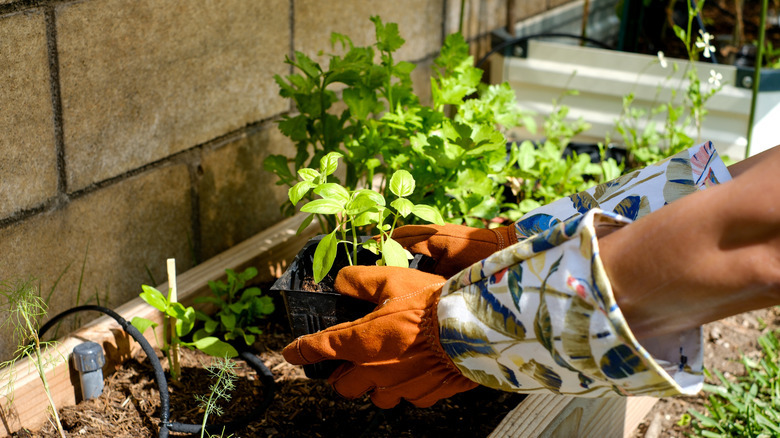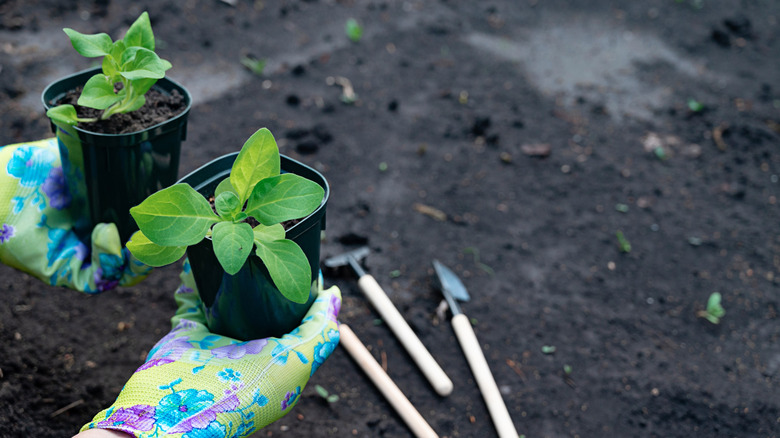How One Small Move Could Harm Your Delicate Herb Garden
Warm spring sunlight streaming through your home's windows may tempt you into moving your herbs outside. But if you make this simple move too early, you may damage your lovingly tended plants, sometimes irreparably. Speaking on this in an exclusive interview, Tiffany Selvey, House Digest's garden editor and in-house master gardener, explains, "Moving some herbs outside too early can definitely kill them. Whether you're starting herbs from seeds or just transitioning plants back out after overwintering them inside, tender plants can be killed by a late frost."
Experienced gardeners may already know that not all herbs are frost-tolerant. Indeed, herbs classified as annuals can be sensitive to surprise late-season chills, which is why sunning them outdoors prematurely can be one of the biggest mistakes people make when growing herbs. "Young basil, cilantro, and dill seedlings will almost certainly be too damaged from a frost to recover," says Selvey. Although she states, "Woodier, frost-tolerant herbs like sage, rosemary, and lavender are better suited to deal with a cold snap," she isn't entirely convinced that these perennials will come away unharmed when exposed to unexpected frostiness. "The shock of moving from indoors to out combined with frost can cause damage. The same is true for other frost-tolerant herbs — they need time to transition to the outdoors before they can take a light frost without being affected." This naturally leads to the question: How can you determine the right time to move your herbs outdoors without risking damage?
Transfer your herbs outside once the threat of frost has passed
The right time to relocate your overwintering herb plants or newly sprouted seedlings is usually when there's little scope for them to encounter late-season frosts (air temperatures 32 degrees Fahrenheit or below). Although estimates about the average last spring freeze dates are available — Almanac has one — with Mother Nature working according to her own whims and fancies, none promise precision. Sharing similar sentiments in her exclusive interview with House Digest, Tiffany Selvey admits, "Knowing your last expected frost date according to your USDA Hardiness Zone can help, but that's just an average of last frost dates in that zone."
Given that, she proposes a nifty solution. "The rule I go by is waiting for that date to pass, then looking at the extended forecast – about two weeks ahead. If there are no low temperatures near freezing, I'll move my herbs and other plants outside." It must be noted, however, that this method isn't completely fool-hardy. "It's good to have a plan in place in case an extra late frost hits," Selvey adds. "It's always better to be safe than sorry when it comes to potentially losing your plants."
Acclimate your herbs before leaving them out for the summer
Knowing the right time to transition indoor herb plants outside is only half the battle; you must also know the right way to go about the process. In her exclusive House Digest interview, Tiffany Selvey explains, "Slowly transitioning your plants outside is ideal but not always possible or necessary. It depends on the herbs you're moving outdoors." According to her, mature woody herbs – like rosemary, lavender, and thyme – can be moved outdoors without slowly acclimating to the elements. But if you're transplanting seedlings, you can harden off these plants once they're 10 weeks old. Hardening involves acclimating plants to outdoor conditions by gradually increasing sun and wind exposure.
"Young seedlings of every type of herb must be hardened off slowly over the course of about a week to adjust to outdoor conditions," says Selvey. Not doing so would be a crucial mistake gardeners make when transplanting seedlings. She reasons, "A tiny basil plant isn't accustomed to full sun, wind, and rain if it's been started indoors under grow lights. A day of full sun will kill young seedlings if they aren't hardened off properly." Put simply, don't site young herb plants in the wrong place. Also, note that "Softer-stemmed mature plants like cilantro and parsley will benefit from being moved to a shady area first. But, keep in mind that these are short-lived plants, so they may bolt as soon as they're moved to the warm outdoors."


